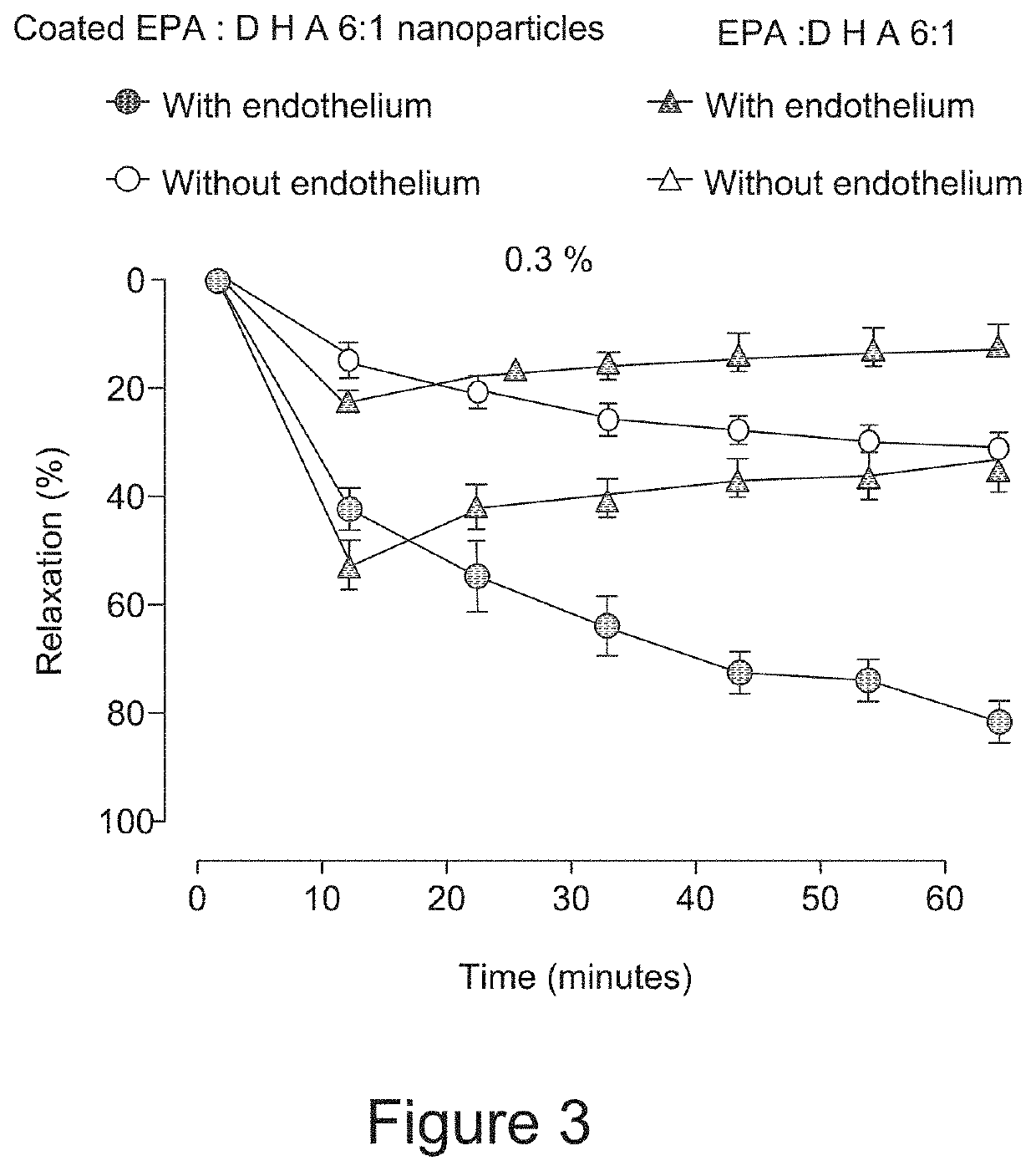Nanoformulations containing encapsulted omega-3 fatty acids
a technology of omega-3 fatty acids and nanoformulations, which is applied in the field of nanoformulations containing encapsulated omega-3 fatty acids, can solve the problems of affecting the brain, affecting the bioavailability of the product, and requiring structural support, so as to achieve the effect of more sustained and higher bioavailability
- Summary
- Abstract
- Description
- Claims
- Application Information
AI Technical Summary
Benefits of technology
Problems solved by technology
Method used
Image
Examples
example 1 — preparation
Example 1—Preparation
[0064]In the present invention nanoparticles were prepared according to an optimized nanoprecipation method described in U.S. Pat. No. 8,852,644, Oct. 7, 2014—Method and Device for Producing Microparticles or Nanoparticles, Baumstuemmler et al. (the disclosure of which is hereby incorporated by reference by utilizing the microjet reactor (MJR) developed by Instillo GMBH, Saarlouis (DE) with solvents optimized for omega-3 fatty acids. The omega-3 fatty acid used in this example was a high purity greater than 90% EPA:DHA 6:1 omega-3 ethyl esters formulation.
[0065]The EPA:DHA in a weight ratio of about 6:1 was emulsified in water phase using phosphatidylcholine and other surfactants. Proteins and gum derivatives were then added to the emulsion form the coating on the omega-3 nanoparticles when the break from the emulsion.
example 2
ization
[0066]The emulsification and coating protocols resulted in stable, encapsulated, EPA:DHA 6:1, nanoparticles with a particle size of 287.8 nm and a particle distribution size (PDI) of 0.107, which were similar after storage for 7 days at room temperature (particle size of 293.4 nm with a PDI value of 0.215) demonstrating the absence of leakage from particles.
[0067]The resulting nanoparticles are water soluble. When added to water or beer, the beverages had no fishy taste or aroma and the nanoparticles are heat resistant.
example 3
[0068]And amount of omega-3 fatty acids in a weight ratio of EPA:DHA of 6:1 was emulsified in water phase using phosphatidylcholine and other surfactants, and then coated with proteins and gum derivatives to increase the stability and dispersibility of the coated omega-3 nanoparticles emulsion as in Example 1. The nanoformulation was then tested for its effects on nitric acid in porcine coronary artery rings.
[0069]Porcine coronary artery rings with and without endothelium were contracted with thromboxane A2 analogue U46619 to about 70% of the maximal contraction induced by high potassium solution before the addition of a single concentration of an omega-3 preparation containing coated and uncoated particles containing EPA and DHA in a weight of 6:1 according to the invention. Thereafter, changes in vascular tone were assessed over a 60 minute period. The results were expressed as a percentage of relaxation and reported as means±SEM (n=5 each group).
[0070]Any changes in the isometric...
PUM
 Login to View More
Login to View More Abstract
Description
Claims
Application Information
 Login to View More
Login to View More - R&D
- Intellectual Property
- Life Sciences
- Materials
- Tech Scout
- Unparalleled Data Quality
- Higher Quality Content
- 60% Fewer Hallucinations
Browse by: Latest US Patents, China's latest patents, Technical Efficacy Thesaurus, Application Domain, Technology Topic, Popular Technical Reports.
© 2025 PatSnap. All rights reserved.Legal|Privacy policy|Modern Slavery Act Transparency Statement|Sitemap|About US| Contact US: help@patsnap.com



